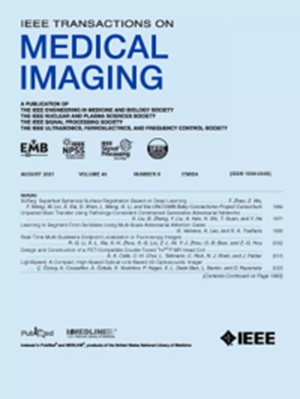JustRAIGS: Justified Referral in AI Glaucoma Screening Challenge.
IF 9.8
1区 医学
Q1 COMPUTER SCIENCE, INTERDISCIPLINARY APPLICATIONS
引用次数: 0
Abstract
A major contributor to permanent vision loss is glaucoma. Early diagnosis is crucial for preventing vision loss due to glaucoma, making glaucoma screening essential. A more affordable method of glaucoma screening can be achieved by applying artificial intelligence to evaluate color fundus photographs (CFPs). We present the Justified Referral in AI Glaucoma Screening (JustRAIGS) challenge to further develop these AI algorithms for glaucoma screening and to assess their efficacy. To support this challenge, we have generated a distinctive big dataset containing more than 110,000 meticulously labeled CFPs obtained from approximately 60,000 patients and 500 distinct screening centers in the USA. Our objective is to assess the practicality of creating advanced and dependable AI systems that can take a CFP as input and produce the probability of referable glaucoma, as well as outputs for glaucoma justification by integrating both binary and multi-label classification tasks. This paper presents the evaluation of solutions provided by nine teams, recognizing the team with the highest level of performance. The highest achieved score of sensitivity at a specificity level of 95% was 85%, and the highest achieved score of Hamming losses average was 0.13. Additionally, we test the top three participants' algorithms on an external dataset to validate the performance and generalization of these models. The outcomes of this research can offer valuable insights into the development of intelligent systems for detecting glaucoma. Ultimately, findings can aid in the early detection and treatment of glaucoma patients, hence decreasing preventable vision impairment and blindness caused by glaucoma.jusstraigs:人工智能青光眼筛查挑战的合理转诊。
青光眼是造成永久性视力丧失的主要原因。早期诊断对于预防青光眼导致的视力丧失至关重要,因此青光眼筛查必不可少。通过应用人工智能来评估彩色眼底照片(CFPs),可以实现一种更实惠的青光眼筛查方法。我们提出了人工智能青光眼筛查的合理转诊(JustRAIGS)挑战,以进一步开发用于青光眼筛查的人工智能算法并评估其有效性。为了支持这一挑战,我们生成了一个独特的大数据集,其中包含来自美国约60,000名患者和500个不同筛查中心的超过110,000个精心标记的cfp。我们的目标是评估创建先进可靠的人工智能系统的可行性,该系统可以将CFP作为输入,并通过整合二元和多标签分类任务,产生可参考青光眼的概率,以及青光眼的判断输出。本文对九个团队提供的解决方案进行了评估,并对绩效最高的团队进行了表彰。在95%特异性水平下,灵敏度最高得分为85%,汉明损失平均最高得分为0.13。此外,我们在外部数据集上测试了前三名参与者的算法,以验证这些模型的性能和泛化。这项研究的结果可以为青光眼检测智能系统的发展提供有价值的见解。最终,这些发现有助于青光眼患者的早期发现和治疗,从而减少由青光眼引起的可预防的视力损害和失明。
本文章由计算机程序翻译,如有差异,请以英文原文为准。
求助全文
约1分钟内获得全文
求助全文
来源期刊

IEEE Transactions on Medical Imaging
医学-成像科学与照相技术
CiteScore
21.80
自引率
5.70%
发文量
637
审稿时长
5.6 months
期刊介绍:
The IEEE Transactions on Medical Imaging (T-MI) is a journal that welcomes the submission of manuscripts focusing on various aspects of medical imaging. The journal encourages the exploration of body structure, morphology, and function through different imaging techniques, including ultrasound, X-rays, magnetic resonance, radionuclides, microwaves, and optical methods. It also promotes contributions related to cell and molecular imaging, as well as all forms of microscopy.
T-MI publishes original research papers that cover a wide range of topics, including but not limited to novel acquisition techniques, medical image processing and analysis, visualization and performance, pattern recognition, machine learning, and other related methods. The journal particularly encourages highly technical studies that offer new perspectives. By emphasizing the unification of medicine, biology, and imaging, T-MI seeks to bridge the gap between instrumentation, hardware, software, mathematics, physics, biology, and medicine by introducing new analysis methods.
While the journal welcomes strong application papers that describe novel methods, it directs papers that focus solely on important applications using medically adopted or well-established methods without significant innovation in methodology to other journals. T-MI is indexed in Pubmed® and Medline®, which are products of the United States National Library of Medicine.
 求助内容:
求助内容: 应助结果提醒方式:
应助结果提醒方式:


